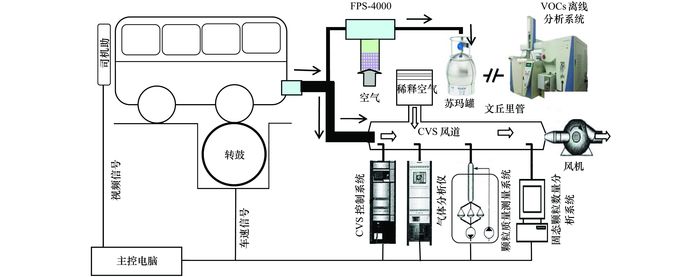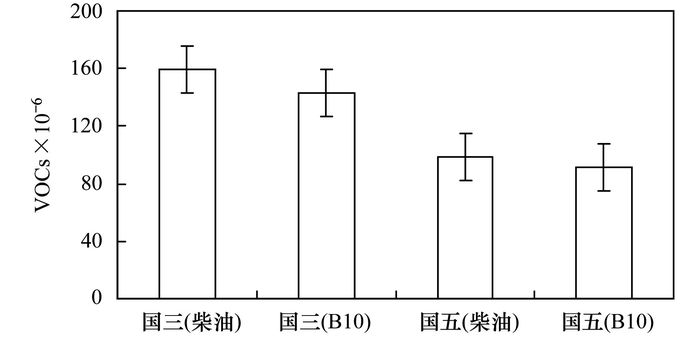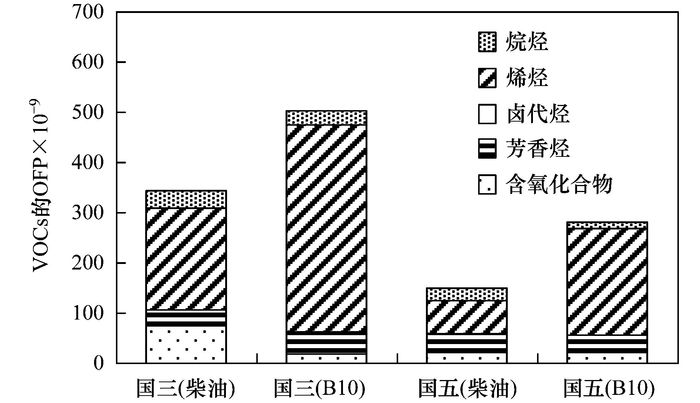2. 上海市环境科学研究院, 上海 200233;
3. 国家环境保护城市大气复合污染成因与防治重点实验室, 上海 200233
2. Shanghai Academy of Environmental Science, Shanghai 200233, China;
3. Key Laboratory for Prevention and Control of Urban Air Pollution in China, Shanghai 200233, China
挥发性有机污染物(volatile organic compounds, VOCs)是大气中普遍存在的一类化合物, VOCs化学活性强, 是光化学污染物生成的主要前体物[1], 也是二次有机气溶胶重要前体物[2], 对环境空气质量和人体健康存在重要危害[3], 各类人为源对区域VOCs的贡献引起研究者的广泛关注[4~7].国内外源解析结果表明, 机动车排放的VOCs占美国墨西哥城[8]、洛杉矶阿苏萨地区[9]、泰国曼谷[10]、伊朗德黑兰[11]城市大气VOCs的58.7%、22%、26%和61%, 国内上海[12]、天津[13]、南京北郊[14]夏季空气VOCs的34%、25.1%和33.1%[14], 并对北京市大气环境影响显著[3].
机动车排放的VOCs中含有大量烷径、烯烃、芳香烃等有毒有害物质, 低碳数烷烃、烯径具有大气化学反应活泼性[15], 是形成光化学烟雾的重要前体物, 芳香烃对二次有机气溶胶贡献最大[16], 不同车型机动车VOCs排放成分谱不同, 汽油车以及摩托车尾气组成中芳香烃比例较高, 柴油车的尾气组成中烷烃比例较高[17], 柴油卡车实际道路尾气VOCs排放中羰基化合物占40%[18], 农用车排放的甲苯、乙醛、二甲苯、对二甲苯等之和是其VOCs排放量的68.6%[19].排放控制技术有利于降低车辆的VOCs排放, 车辆行驶里程增加则VOCs排放增大[20], 汽油车起动工况排放的VOCs数量较高[21], 随着排放标准的加严, 汽油车VOCs排放降低[22].
生物柴油具有可再生性好等优点, 可直接在柴油机上使用[23].目前, 生物柴油VOCs排放特性研究较少, 且集中在发动机上.例如:Peng等[24]的研究表明, 发动机使用混合比例为20%的生物柴油混合燃料后, 其VOCs排放降低61.2%; Hu等[25]在一台单缸柴油上分析了乙醇-生物柴油-柴油混合燃料对发动机VOCs排放的影响.有关柴油车使用生物柴油后的VOCs成分谱研究未见报道.
本文以国三、国五柴油公交车为研究对象, 在重型底盘测功机上运行中国典型城市公交循环, 分析其使用柴油、体积混合比例为10%的废食用油制生物柴油-柴油混合燃料的污染物排放及VOCs成分谱特征.
1 材料与方法 1.1 试验样车及燃料试验样车为分别满足国三、国五排放的柴油公交车, 安装高压共轨六缸增压中冷柴油机, 主要技术参数如表 1所示.试验燃料为国五柴油、国五柴油与废食用油制生物柴油按10%体积比混合的柴油-生物柴油混合燃料(B10), 柴油及B10的主要理化指标如表 2所示.
|
|
表 1 试验样车主要技术参数 Table 1 Main technical parameters of the test vehicle |
|
|
表 2 柴油与B10主要理化指标 Table 2 Main physical and chemical indices of diesel and B10 |
1.2 试验装置及循环
试验装置包括MAHA-AIP重型底盘测功机, 日本Horiba公司的全流稀释采样系统(Constant volume dilution sampling system, CVS)、气体排放分析系统、颗粒物质量、固态PM2.5数量测量系统, 芬兰DEKATI公司的射流稀释器(Fine Particle Sampler-4000, FPS-4000), 苏玛采样罐等.测试系统所用的仪器设备如表 3所示, 试验装置如图 1所示.
|
|
表 3 重型底盘测功机排放测试系统组成 Table 3 Composition of emission test system of heavy-duty chassis dynamometer |

|
图 1 试验装置示意 Fig. 1 Schematic diagram of experimental setup |
试验时将公交车固定在底盘测功机上, 根据车辆最大总质量的70%加载, 通过滑行确定阻力系数, 试验车辆为冷车状态.试验循环采用GB/T 19754-2005《重型混合动力电动汽车能量消耗量试验方法》推荐的中国典型城市公交循环.该循环由怠速、低速、匀速、中速和中高速等工况构成, 运行时间1 314 s, 平均车速16.16 km·h-1, 最高车速60 km·h-1.该循环与公交车实际行驶时低平均车速、高比例怠速, 发动机低转矩、低转速等工况特点吻合较好[26].试验时驾驶员根据司机助屏幕显示的车速-时间曲线驾驶车辆, 车辆速度误差区间为该时目标车速的±3 km·h-1.通过实际驾驶循环与理论循环的相关性系数(>0.95)来判断试验的有效性.试验时利用CVS系统测量车辆气体及颗粒物排放, 同时利用射流稀释器抽取部分尾气, 稀释比8.21, 稀释温度120℃, 利用苏玛罐采集稀释后的尾气, 再进行离线VOCs组分分析.
VOCs样品采用TH_PKU-300(武汉天虹)挥发性有机物监测系统分析.样品分两路抽入仪器中, 其中的VOCs分别被超低温预浓缩系统冷冻富集, 经热解析后进入色谱柱, 其中一路(C2~C5的碳氢化合物)由FID检测器检出, 另一路(C5~C10的碳氢化合物、卤代烃和含氧挥发性有机物)由MS检测器检出.本研究采用PAMS和其他50余种含氧VOCs和卤代烃标准气体(美国Spectra Gases公司)进行VOCs的定性和定量, 共计定量分析106种VOCs, 分别为30种烷烃、11种烯烃、17种芳香烃、29种卤代烃、18种含氧VOC以及乙炔.仪器对不同VOC物种的检测体积分数限值为几十到几百万亿分之一.仪器每分析5个样品加插1个氮气样和1个1×10-9体积分数的PAMS标准气体样品的分析, 用来跟踪评估仪器响应的稳定性和准确性.
2 结果与讨论 2.1 污物物排放国三、国五柴油公交车使用柴油、B10的THC、CO、NOx、PM和固态PM2.5数量排放如表 4所示.
|
|
表 4 试验国三、国五公交车污染物排放 Table 4 Emission factors of diesel buses certified to meet China Ⅲ and China V and fueled with diesel and B10 |
由表 4可见, 与国三柴油公交车比较, 国五柴油公交车的THC、CO、PM和固态PM2.5数量排放分别降低39.3%、19.9%、77.4%和28.4%, NOx排放升高31.7%.这是因为, 国五柴油公交车采用了缸内清洁燃烧降低颗粒物+选择性催化还原SCR尾气后处理装置降低NOx的技术路线, 缸内清洁燃烧技术导致国五公交车THC、CO、PM和固态PM2.5数量排放降低; 另一方面, 由于公交车试验循环的负荷相对较低, 排气温度较低, 致使SCR系统效率偏低, 国五公交车的NOx排放高于国三公交车.北京市国四、国五公交车实际道路试验结果表明[27~29]:国四公交车可有效降低其CO、THC、PM排放, 但由于公交车实际运行工况的排气温度较低, 致使SCR系统效率较低, 国四公交车的NOx排放高于国三公交车, 当公交车车速>30 km·h-1时, SCR才能逐渐呈现出其对NOx的降低效果.
同时由表 4可见, 与使用柴油比较, 国三、国五柴油公交车使用B10的THC、CO、PM和固态PM2.5数量排放降低, 国三柴油车的NOx排放增加, 国五柴油车的NOx排放降低.这是因为, 生物柴油含氧, 促进燃烧, THC、CO、PM和固态PM2.5数量排放降低, NOx排放增加[23, 30]; 另一方面, 发动机使用生物柴油后导致其排温升高[31], 提高了SCR系统工作效率, 这可能是国五公交车使用B10后其NOx排放降低的主要原因.
2.2 VOCs成分谱试验国三、国五柴油公交车使用柴油、B10的VOCs排放如图 2所示.从中可见, 与国三柴油公交车比较, 国五柴油公交车的VOCs排放降低37.8%;与使用柴油比较, 国三、国五公交车使用B10后的VOCs排放分别降低10.3%和7.3%.这是因为, 缸内清洁燃烧技术导致国五公交车VOCs排放降低; 同时, B10的含氧特性改善了燃料在缸内的燃烧, VOCs降低.尤可为等[32]的研究结果表明:B20发动机欧洲稳定循环的VOCs排放降低了42.98%.由于中国典型城市公交循环发动机工况不同, 且生物柴油混合比例不同, 本研究得到的VOCs降低比例相对较低.

|
图 2 试验国三、国五公交车VOCs排放 Fig. 2 VOCs emissions from diesel buses certified to meet China Ⅲ and China V fueled with diesel and B10 |
试验国三、国五柴油公交车使用柴油、B10的VOCs成分谱如表 5所示.由表 5可见, 试验柴油公交车的VOCs成分谱中包括26类烷径、8类烯烃、1类卤代烃、19类芳香烃和15类含氧化合物.
|
|
表 5 国三、国五公交车使用柴油、B10的VOCs体积分数成分谱×10-9 Table 5 VOCs source profiles from diesel buses certified to meet China Ⅲ and China V fueled with diesel and B101×10-9 |
对试验国三、国五公交车使用柴油、B10的VOCs成分谱中烷径、烯烃、卤代烃、芳香烃和含氧化合物进行统计, 各类VOCs排放量及其占VOCs总排放的百分比如图 3所示.由图 3(a)可见, 国三柴油公交车排放的VOCs成分谱中醛酮类含氧化合物比例最高, 其次为烷烃和烯烃, 卤代烃和芳香烃排放较少.国五柴油公交车排放的VOCs成分谱中酮类含氧化合物比例较高, 其次为烷烃, 芳香烃、烯烃和卤代烃.由图 3(b)可见, 与国三柴油公交比较, 国五柴油公交车排放的VOCs成分谱中烷径、烯烃、卤代烃、芳香烃、含氧化合物均有所降低.与使用柴油比较, 国三、国五柴油公交车使用B10后烷烃、芳香烃略有降低, 烯烃排放增加, 醛酮类含氧化合物明显降低.

|
图 3 国三、国五公交车使用柴油、B10的VOCs分类排放 Fig. 3 VOCs from diesel buses certified to meet China Ⅲ and China V fueled with diesel and B10 |
VOCs的大气反应活性指VOCs中的各类成分参与大气化学反应的能力, 本研究采用VOCs物种臭氧生成潜势(ozone formation potential, OFP)来评价VOCs的大气反应活性.具体而言, VOC物种的OFP等于该物种环境浓度与其在臭氧最大增量反应(maximum incremental reactivity, MIR)中的臭氧生成系数的乘积.国三、国五柴油公交车VOCs排放的大气反应活性如图 4所示, 其中, 使用的VOC最大反应生成系数来自文献[33].由图 4可见, 与国三柴油公交比较, 由于国五柴油公交车VOC成分谱中烷径、烯烃、卤代烃、芳香烃、含氧化合物均有所降低, 其VOCs排放的大气反应活性降低了56%, VOCs的臭氧生成潜势(OFP)降低, 对二次有机气溶胶的生成潜势减弱.与使用柴油比较, 国三、国五公交车使用B10后, 虽然其VOCs排放总量、含氧化合物明显降低, 但由于其烯烃排放增加, 导致生物柴油公交车VOCs排放的大气反应活性增强.

|
图 4 试验国三、国五公交车VOCs大气反应活性 Fig. 4 OFP of VOCs from diesel buses certified to meet China Ⅲ and China V fueled with diesel and B10 |
(1) 与国三柴油公交车比较, 国五柴油公交车的THC、CO、PM和固态PM2.5数量排放分别降低39.3%、19.9%、77.4%和28.4%, NOx排放升高31.7%.与使用柴油比较, 国三、国五柴油公交车使用B10的THC、CO、PM和固态PM2.5数量排放降低, 国三柴油车的NOx排放增加, 国五柴油车的NOx排放降低.
(2) 柴油公交车的VOCs成分谱中包括烷径、烯烃、卤代烃、芳香烃和含氧化合物.国三柴油公交车排放的VOCs成分谱中含氧化合物比例最高, 其次为烷烃和烯烃, 卤代烃和芳香烃排放较少.国五柴油公交车排放的VOCs成分谱含氧化合物比例较高, 其次为烷烃, 芳香烃、烯烃和卤代烃.与国三柴油公交车比较, 国五柴油公交车VOCs成分谱中的烷径、烯烃、卤代烃、芳香烃和含氧化合物等均降低; 与使用柴油比较, 国三、国五柴油公交车使用B10后的烯烃排放增加, 含氧化合物排放降低.
(3) 与国三柴油公交比较, 国五柴油公交车VOCs排放的大气反应活性降低了56%, VOCs的臭氧生成潜势降低, 对二次有机气溶胶的生成潜势减弱.与使用柴油比较, 国三、国五公交车使用B10后的烯烃排放增加, VOCs的大气反应活性增强.
| [1] |
张远航, 邵可声, 唐孝炎, 等. 中国城市光化学烟雾污染研究[J]. 北京大学学报(自然科学版), 1998, 34(2-3): 392-400. Zhang Y H, Shao K S, Tang X Y, et al. The study of urban photochemical smog pollution in China[J]. Acta Scientiarum Naturalium Universitatis Pekinensis, 1998, 34(2-3): 392-400. |
| [2] | 唐孝炎, 张远航, 邵敏. 大气环境化学[M]. 第二版. 北京: 高等教育出版社, 2006. |
| [3] |
罗达通, 高健, 王淑兰, 等. 北京秋季大气挥发性有机物及相关污染物特征分析[J]. 中国科学院大学学报, 2014, 31(3): 329-336. Luo D T, Gao J, Wang S L, et al. Characteristics of volatile organic compounds and relative pollutants observed in autumn in Beijing[J]. Journal of University of Chinese Academy of Sciences, 2014, 31(3): 329-336. |
| [4] |
罗达通, 高健, 王淑兰, 等. 上海秋季大气挥发性有机物特征及污染物来源分析[J]. 中国环境科学, 2015, 35(4): 987-994. Luo D T, Gao J, Wang S L, et al. Characteristics of volatile organic compounds and relative pollutants observed in autumn Shanghai[J]. China Environmental Science, 2015, 35(4): 987-994. |
| [5] |
刘芮伶, 翟崇治, 李礼, 等. 重庆主城区夏秋季挥发性有机物(VOCs)浓度特征及来源研究[J]. 环境科学学报, 2017, 37(4): 1260-1267. Liu R L, Zhai C Z, Li L, et al. Concentration characteristics and source analysis of ambient VOCs in summer and autumn in the urban area of Chongqing[J]. Acta Scientiae Circumstantiae, 2017, 37(4): 1260-1267. |
| [6] |
张玉欣, 安俊琳, 林旭, 等. 南京北郊冬季挥发性有机物来源解析及苯系物健康评估[J]. 环境科学, 2017, 38(1): 1-12. Zhang Y X, An J L, Lin X, et al. Source apportionment of volatile organic compounds and health assessment of benzene series in northern suburb of Nanjing in winter[J]. Environmental Science, 2017, 38(1): 1-12. |
| [7] |
刘刚, 盛国英, 傅家谟, 等. 香港大气中有毒挥发性有机物研究[J]. 环境化学, 2000, 19(1): 61-66. Liu G, Sheng G Y, Fu J M, et al. Hazardous volatile organic compounds in ambient air in Hong Kong[J]. Environmental Chemistry, 2000, 19(1): 61-66. |
| [8] | Vega E, Mugica V, Carmona R, et al. Hydrocarbon source apportionment in Mexico City using the chemical mass balance receptor model[J]. Atmospheric Environment, 2000, 34(24): 4121-4129. DOI:10.1016/S1352-2310(99)00496-3 |
| [9] | Brown S G, Frankel A, Hafner H R. Source apportionment of VOCs in the Los Angeles area using positive matrix factorization[J]. Atmospheric Environment, 2007, 41(2): 227-237. DOI:10.1016/j.atmosenv.2006.08.021 |
| [10] | Suwattiga P, Limpaseni W. Seasonal source apportionment of volatile organic compounds in Bangkok ambient air[J]. Scienceasia, 2005, 31: 395-401. DOI:10.2306/scienceasia1513-1874.2005.31.395 |
| [11] | Sarkhosh M, Mahvi A H, Yunesian M, et al. Source apportionment of volatile organic compounds in Tehran, Iran[J]. Bulletin of Environmental Contamination and Toxicology, 2013, 90(4): 440-445. DOI:10.1007/s00128-012-0948-5 |
| [12] |
蔡长杰, 耿福海, 俞琼, 等. 上海中心城区夏季挥发性有机物(VOCs)的源解析[J]. 环境科学学报, 2010, 30(5): 926-934. Cai C J, Geng F H, Yu Q, et al. Source apportionment of VOCs at city centre of Shanghai in Summer[J]. Acta Scientiae Circumstantiae, 2010, 30(5): 926-934. |
| [13] |
韩萌, 卢学强, 冉静, 等. 天津市城区夏季VOCs来源解析[J]. 环境科学与技术, 2011, 34(10): 76-80. Han M, Lu X Q, Ran J, et al. Source apportionment of volatile organic compounds in urban Tianjin in the summer[J]. Environmental Science & Technology, 2011, 34(10): 76-80. DOI:10.3969/j.issn.1003-6504.2011.10.017 |
| [14] |
杨辉, 朱彬, 高晋徽, 等. 南京市北郊夏季挥发性有机物的源解析[J]. 环境科学, 2013, 34(12): 4519-4528. Yang H, Zhu B, Gao J H, et al. Source apportionment of VOCs in the northern suburb of Nanjing in Summer[J]. Environmental Science, 2013, 34(12): 4519-4528. |
| [15] |
王伯光, 邵敏, 张远航. 机动车排放中挥发性有机污染物的组成及其特征研究[J]. 环境科学研究, 2006, 19(6): 75-80. Wang B G, Shao M, Zhang Y H, et al. A study of volatile organic compounds and its emission factors from city vehicles[J]. Research of Environmental Sciences, 2006, 19(6): 75-80. |
| [16] |
于艳, 王秀艳, 杨文. 天津市机动车二次有机气溶胶生成潜势的估算[J]. 中国环境科学, 2015, 35(2): 381-386. Yu Y, Wang X Y, Yang W. Estimate of vehicles generation of secondary organic aerosols of Tianjin[J]. China Environmental Science, 2015, 35(2): 381-386. |
| [17] |
区家敏, 冯小琼, 刘郁葱, 等. 珠江三角洲机动车挥发性有机物排放化学成分谱研究[J]. 环境科学学报, 2014, 34(4): 826-834. Ou J M, Feng X Q, Liu Y C, et al. Source characteristics of VOCs emissions from vehicular exhaust in the Pearl River Delta Region[J]. Acta Scientiae Circumstantiae, 2014, 34(4): 826-834. |
| [18] | Yao Z L, Shen X B, Ye Y, et al. On-road emission characteristics of VOCs from diesel trucks in Beijing, China[J]. Atmospheric Environment, 2015, 103: 87-93. DOI:10.1016/j.atmosenv.2014.12.028 |
| [19] | Yao Z L, Wu B B, Shen X B, et al. On-road emission characteristics of VOCs from rural vehicles and their ozone formation potential in Beijing, China[J]. Atmospheric Environment, 2015, 105: 91-96. DOI:10.1016/j.atmosenv.2015.01.054 |
| [20] |
傅晓钦, 翁燕波, 钱飞中, 等. 行驶机动车尾气排放VOCs成分谱及苯系物排放特征[J]. 环境科学学报, 2008, 28(6): 1056-1062. Fu X Q, Weng Y B, Qian F Z, et al. Study of the VOC source profile and benzene compounds emission of various motor vehicles[J]. Acta Scientiae Circumstantiae, 2008, 28(6): 1056-1062. |
| [21] | 张铁臣, 宋崇林, 范嘉睿, 等. 汽油车尾气VOC排放特性研究[A]. 见: 2007年燃烧学学术会议论文集[C]. 天津: 中国工程热物理学会, 2007. |
| [22] | Cao X Y, Yao Z L, Shen X B, et al. On-road emission characteristics of VOCs from light-duty gasoline vehicles in Beijing, China[J]. Atmospheric Environment, 2016, 124: 146-155. DOI:10.1016/j.atmosenv.2015.06.019 |
| [23] |
胡志远, 谢亚飞, 谭丕强, 等. 在用国Ⅳ公交车燃用B5生物柴油的排放特性[J]. 同济大学学报(自然科学版), 2016, 44(4): 625-631. Hu Z Y, Xie Y F, Tan P Q, et al. Emission characteristics of an In-use China Four diesel bus fueled with B5[J]. Journal of Tongji University (Natural Science), 2016, 44(4): 625-631. |
| [24] | Peng C Y, Lan C H, Yang C Y. Effects of biodiesel blend fuel on volatile organic compound (VOC) emissions from diesel engine exhaust[J]. Biomass and Bioenergy, 2012, 36: 96-106. DOI:10.1016/j.biombioe.2011.10.016 |
| [25] | Hu N T, Tan J W, Wang X Y, et al. Volatile organic compound emissions from an engine fueled with an ethanol-biodiesel-diesel blend[J]. Journal of the Energy Institute, 2017, 90(1): 101-109. DOI:10.1016/j.joei.2015.10.003 |
| [26] |
胡志远, 磨文浩, 宋博, 等. 在用国Ⅲ/国Ⅳ/国Ⅴ柴油公交车的颗粒物质量及固态PM2.5数量排放特性[J]. 环境科学研究, 2016, 29(10): 1426-1432. Hu Z Y, Mo W H, Song B, et al. Emission characteristics of particulate matter mass and quantity of solid PM2.5 from In-use China Ⅲ/Ⅳ/Ⅴ diesel buses[J]. Research of Environmental Sciences, 2016, 29(10): 1426-1432. |
| [27] |
郭佳栋, 葛蕴珊, 谭建伟, 等. 国Ⅳ公交车实际道路排放特性[J]. 环境科学研究, 2014, 27(5): 477-483. Guo J D, Ge Y S, Tan J W, et al. Real-world emission characteristics of China Ⅳ buses[J]. Research of Environmental Sciences, 2014, 27(5): 477-483. |
| [28] |
郭佳栋, 葛蕴珊, 谭建伟, 等. 国Ⅴ公交车实际道路排放特性研究[J]. 汽车工程, 2015, 37(1): 120-124. Guo J D, Ge Y S, Tan J W, et al. A research on the real world emission characteristics of State-V Buses[J]. Automotive Engineering, 2015, 37(1): 120-124. |
| [29] |
郭佳栋, 葛蕴珊, 郝利君, 等. SCR系统对公交车NOx排放降低效果的研究[J]. 汽车工程, 2015, 37(11): 1227-1232. Guo J D, Ge Y S, Hao L J, et al. A research on the NOx reduction effects of SCR systems in city buses[J]. Automotive Engineering, 2015, 37(11): 1227-1232. DOI:10.3969/j.issn.1000-680X.2015.11.001 |
| [30] |
楼狄明, 孔德立, 强蔷, 等. 国Ⅴ柴油机燃用柴油/生物柴油排放性能试验[J]. 农业机械学报, 2014, 45(9): 25-30. Lou D M, Kong D L, Qiang Q, et al. Emission experiment on a Chinese V diesel engine fueled with diesel/biodiesel[J]. Transactions of the Chinese Society for Agricultural Machinery, 2014, 45(9): 25-30. DOI:10.6041/j.issn.1000-1298.2014.09.005 |
| [31] |
毛功平, 王忠, 吴婧, 等. 高压共轨柴油机燃用生物柴油的排放特性分析[J]. 车用发动机, 2013(6): 62-67, 74. Mao G P, Wang Z, Wu J, et al. Emission characteristics of high-pressure common rail diesel engine fuelled with Biodiesel[J]. Vehicle Engine, 2013(6): 62-67, 74. |
| [32] |
尤可为, 葛蕴珊, 何超, 等. 柴油机燃用生物柴油的非常规污染物排放特性[J]. 内燃机学报, 2010, 28(6): 506-509. You K W, Ge Y S, He C, et al. Unregulated emissions from a diesel engine fueled with biodiesel[J]. Transactions of CSICE, 2010, 28(6): 506-509. |
| [33] | Duan J C, Tan J H, Yang L, et al. Concentration, sources and ozone formation potential of volatile organic compounds (VOCs) during ozone episode in Beijing[J]. Atmospheric Research, 2008, 88(1): 25-35. DOI:10.1016/j.atmosres.2007.09.004 |
 2018, Vol. 39
2018, Vol. 39

